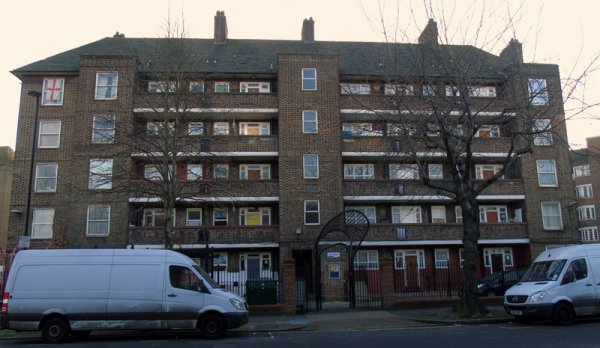Jul 13th 2022, 19:48
Blog - 13th July 2022
In this blog I consider the ‘time bomb’ that the cost of living crisis is creating for tenants, councils and housing associations and what could be done about it; the crisis in NHS dentistry that is leading people to carry out ‘do it yourself’ tooth extractions; webinars and briefing papers.
The ‘cost of living crisis’ is rightly receiving a lot of attention, but there is one aspect of it that is not, and that is the question of rent increases in social housing owned and managed by councils and housing associations.

Lambeth Council's Briant estate
Central government effectively controls social rents in England. Current policy is that rent increases are limited to the increase in the consumer prices index (CPI) plus 1%. This provides for a real increase in rents for landlords each year that enables them to meet inflationary pressures and often provides resources to fund new development. The model is based on the assumption that tenants will be able to afford these rent increases because, with inflation usually at about 2% increases will be about 3%; most tenants are in receipt of housing benefit or universal credit that will meet the cost of the rent increases; and tenants who are not in receipt of housing benefit or universal credit will probably be experiencing a real increase in their own incomes each year.
However, this situation is no longer the case. The rent increase for April 2023 will be set with reference to the consumer prices index in September 2022 that is forecast to be between 10% and 11%. This means that rents would increase by up to 12%. At the same time, tenants in receipt of housing benefits or universal credit are no longer guaranteed to get their rent reimbursed in full; while tenants who are not in receipt of housing benefits or universal credit are unlikely to be seeing increases in their incomes (whether pensions, salaries or wages) of up to 12%.
An increase in social rents of up to 12% would therefore result in increased financial hardship for many tenants and increasing costs to landlords in rent collection, rent arrears and bad debts.

Wakefield & District Housing Association houses in Crofton, West Yorkshire
Of course, it would be open to councils and housing associations to impose a smaller rent increase in the interests of keeping rents affordable, but there would be problems with this approach. First, landlords are facing inflationary cost increases themselves – especially in building maintenance and construction – that has to be funded, and interest rates are also forecast to increase; Second, the government does not allow a landlord to opt for a smaller increase in one year and then for a larger increase in the next – each year’s rent increase is based on the previous year’s rent and so any reduction in rents is permanent and cannot be reversed.
In my view the increase in inflation, especially if we are entering a period where inflation will be high and may vary significantly from year to year, has broken the government’s existing policies on social rent and welfare. I think a new approach is needed that would include the following elements:
The problem with this is that councils and housing associations would still be faced with inflationary pressures that rent increases may not be large enough to cover. This would impact especially on development programmes and in my view government should react to that by increasing the level of social housing grant that funds the development of new social and affordable housing.
And the government doesn’t have much time to react to this problem. Councils and housing associations need to set their rents in January and a change in social rent policy would probably require legislation and / or consultation. If they do nothing, tenants, councils and housing associations will find themselves sitting on a time bomb that will go off in April 2023.
Of course, the cost of living crisis is having the same impact in Scotland and Wales, but the rent influencing regimes in those countries are not as rigid and bureaucratic as that in England.
I will be holding webinars on local authority housing finance in September. Details are available on my website. For further information or to book your place, please click here.
My local newspaper is the ‘Cumberland & Westmorland Herald’ and they recently highlighted the shocking decline in NHS dental services in the Eden area of Cumbria. However, this isn’t new. It is a problem that has been developing nationally over many years, was already serious before the pandemic, and has now reached crisis proportions. The impact is generally worst in rural areas such as the Eden Valley.
‘Mydentist, Britain’s largest provider of NHS dentistry reports that 16million people in England don’t have a dentist, 53% of people haven’t seen a dentist for over a year, mainly because they can’t get an appointment, while one in five has carried out ‘do it yourself’ dentistry including tooth extractions and fillings.
The British Dental Association says that dentistry went into the pandemic on a lower budget than it received a decade before – cut in real terms by 30%, with half of the population unfunded to receive NHS treatment. They also say that dentistry is haemorrhaging talent owing to failed contracts, underfunding and a ‘cack-handed’ Covid response. There were 951 fewer dentists offering NHS services in 2020/21 than in the previous year, and more than 40% say they intend to change career or retire. Dentists are also leaving the NHS so they can concentrate on private treatment.
NHS England advises anyone who is in pain and cannot find a dentist to call NHS 111. They say that patients should only visit Accident & Emergency in serious circumstances, such as severe pain; heavy bleeding; or injuries to the face, mouth or teeth.
Central to the problem is the target-based NHS contract. It was introduced in 2006 by the Labour government and has been retained by the Conservatives. It pays dentists on their activity, giving them targets to meet and penalising them financially if they don’t meet them. Treatment is divided into three bands; the most complex care requires dentists to pay the laboratory fee themselves that can be as much as several hundred pounds per patient. NHS dentists can therefore lose money when they treat patients who need significant treatment. It has generated chronic recruitment and retention problems that have been exacerbated by restrictions on foreign dentists and has inevitably led to the slow but certain decline of the service.
In January, the government said it would provide another £50million of funding. But this is a small one-off sum that will not reverse the decline in NHS dentistry. As usual the government has a short-term penny-pinching approach. Lack of NHS dentists is not only causing hardship and suffering to patients but is storing up significant health problems that will cost the NHS dearly in the long-term. We need to commit to continuing to have an NHS dental service. We need more funding, more dentists to be appointed and reform of the NHS contracts.
Since I last wrote a blog I have published several new briefing papers. Your copies can be freely downloaded by clicking on the following links: